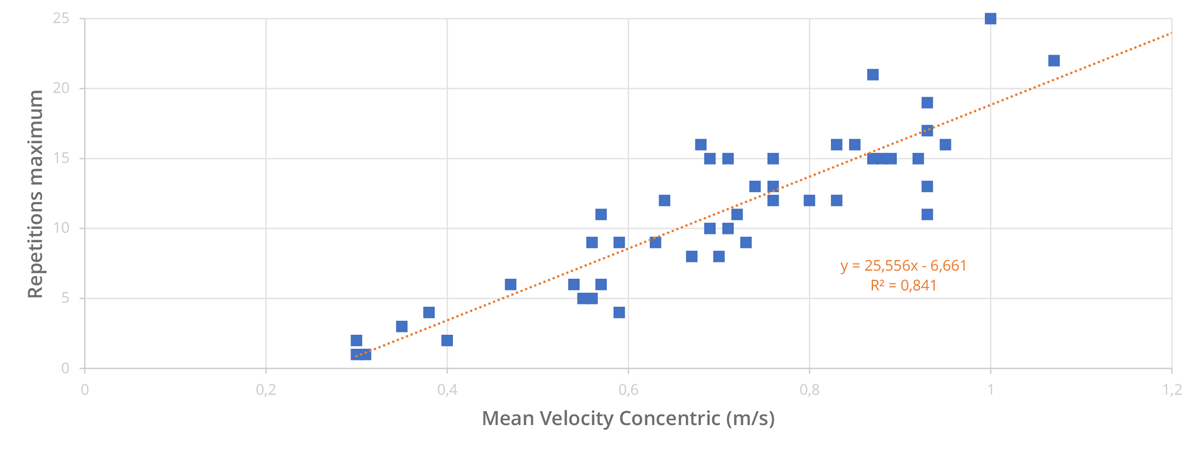
With the expansion of inertial sensors that measure acceleration (Push, The Beast, to name only the most recent ones) and linear transducers that measure displacement (GymAware, Open Barbell, Tendo Sport), velocity-based training (VBT) has become increasingly popular in resistance training. The general idea is that there is a relationship between relative loads and movement velocity, and that this relationship would allow for an accurate determination of 1RM and a way to train more accordingly with the fatigue level of the moment (see our complete review on velocity-based training).
Velocity-based training is often applied to exercises with additional loads (bench press, squat, deadlift, etc.), the sensor being placed on the load. However, in a conventional workout and in fitness testing for sport exams or certain professions (Military, firefighters, police services, etc.), bodyweight exercises (that is, without additional charges) are often used. Pull-ups are one of the main exercises used in these tests. Pull-ups are very functional because they are necessary on the filed in many situations for the organizations mentioned above and they are also a very good way to know the relative strength of an individual.
However, to test the performance of individuals in this exercise, it is generally required to perform a set to failure to determine the maximum repetitions. When these tests are done regularly on a large group of individuals, it can be time consuming. If velocity-based training can be used to determine 1RM, is there a link between the velocity of one pull-up repetition and the maximum pull-ups repetitions that can be performed in a single set to failure ?
To answer this question, American researchers have studied whether there is a link between mean concentric velocity during a single pull-up and the maximum pull-ups repetitions that an individual can achieve in a single set. For this, researchers recruited 49 people, 7 women and 42 men, who can achieve at least 2 complete pull-ups.
The protocol consisted, during the same session, to perform a specific warm-up composed of several sets of assisted pull-ups, then after 20 minutes of rest, all the participants realized a single pull-up then after 2 minutes, a set of pull-ups performed to failure. Each pull-up had to be complete, that is, between each repetition, the arms were completely extended, and at the end of the concentric phase, the chin had to pass over the bar. For the single pull-up and the set to failure, the mean concentric velocity of each repetition was measured using a linear transducer (GymAware). For statistical analyzes, the highest velocity between the repetition of the single set and the first repetition of the set to failure was chosen.
The main results of this study show that there is a strong positive linear relationship (R² = 0.841) between the mean concentric velocity of the first repetition and the maximum pull-ups repetitions in a set to failure. This implies that the concentric mean velocity of the first repetition can predict the maximum pull-ups repetitions in a set to failure (Fig. 1), with an average prediction error of 2.07 repetitions.

Figure 1. Maximum number of pull-ups repetition vs. mean concentric velocity.
The prediction of the maximum pull-ups repetitions can be complicated by the heterogeneity of the performances of the participants. Indeed, the subjects achieved an average of 11.3 ± 5.6 pulls (ranging from 1 to 25). The more a person will be able to do many repetitions, the more difficult it will be to predict this performance via the mean concentric velocity. Therefore, for greater accuracy, prediction equations should be established on populations with a homogeneous level.
This study shows that there is a relationship between the mean concentric velocity of a single pull-up and the number of pull-ups that can be achieved during a set to failure. This implies that it is not necessary to systematically test until failure, the mean concentric velocity measured during a single repetition may be sufficient to evaluate the progress of the athletes and manage their progress. If the prediction is stable over time, increasing the speed on a single repetition could be an indicator of the improvement in the maximum number of pull-ups. In addition, testing a whole group of individuals can take time, while the measurement of a single repetition is very fast.
However, the equation provided by this study comes from a statistical analysis valid for the group tested, the main limitation here being the great heterogeneity of the participants level. This management principle is therefore very interesting for a group of homogeneous level. Further studies will be needed to confirm the value of using velocity-based training in bodyweight exercises.
We remind you that you can quote articles by limiting your quotation to 200 words maximum and you must include a nominative link to this one. Any other use, especially copying in full on forum, website or any other content, is strictly prohibited. In doubt, contact us.
Copyright © 2011-2024 - www.sci-sport.com - All rights reserved